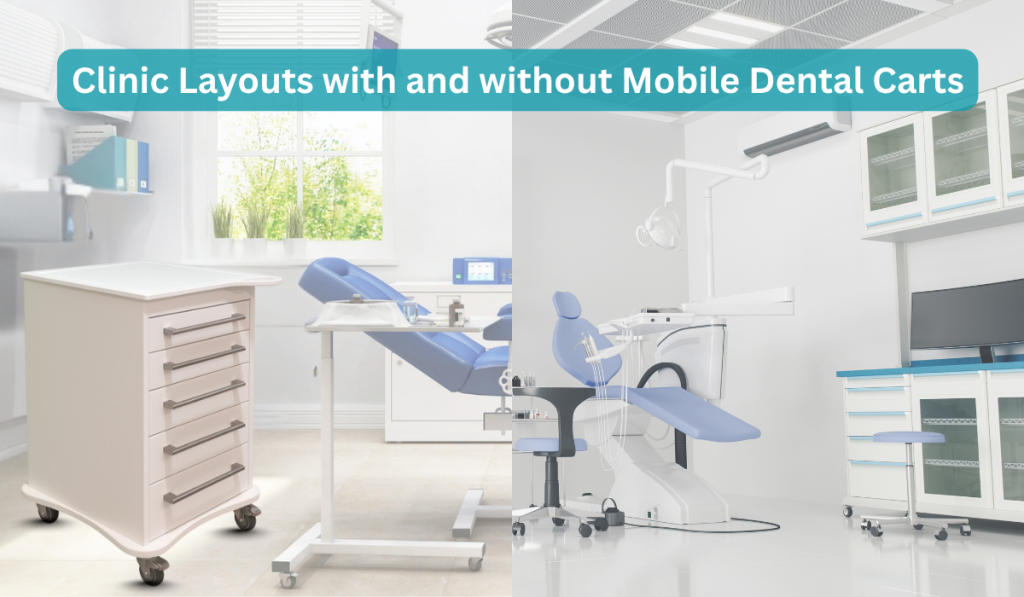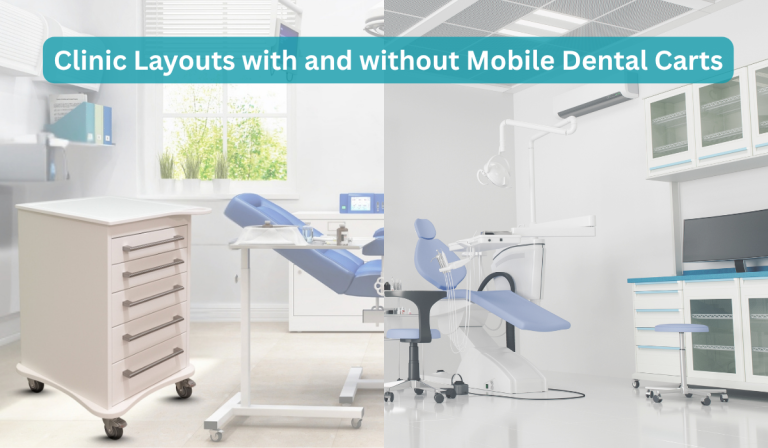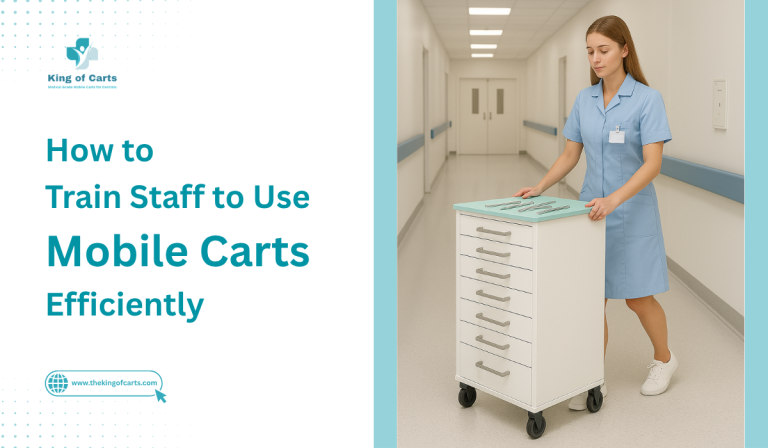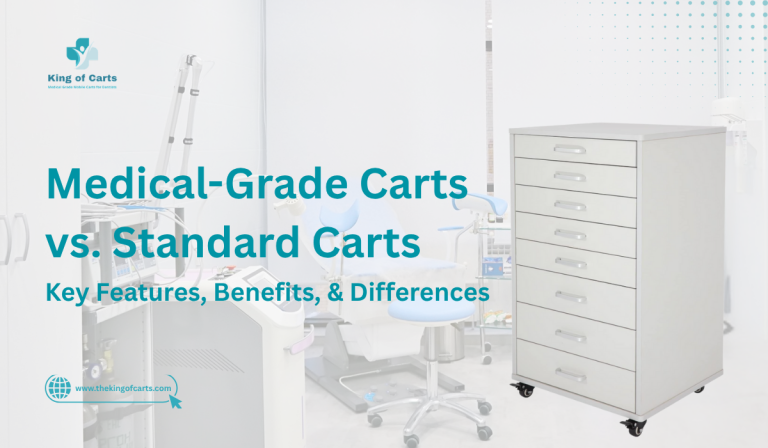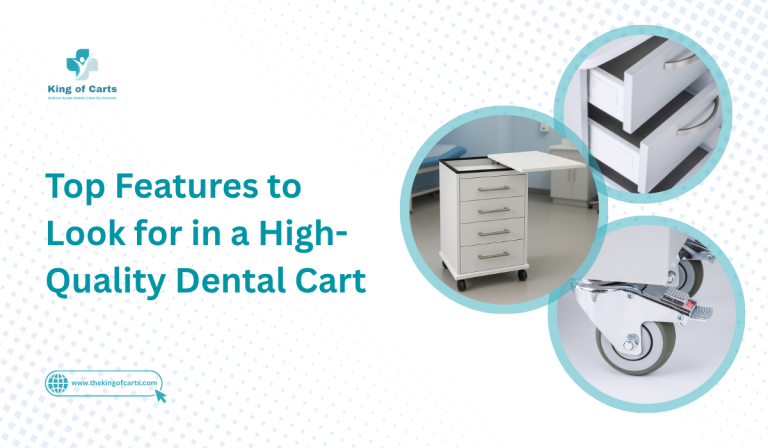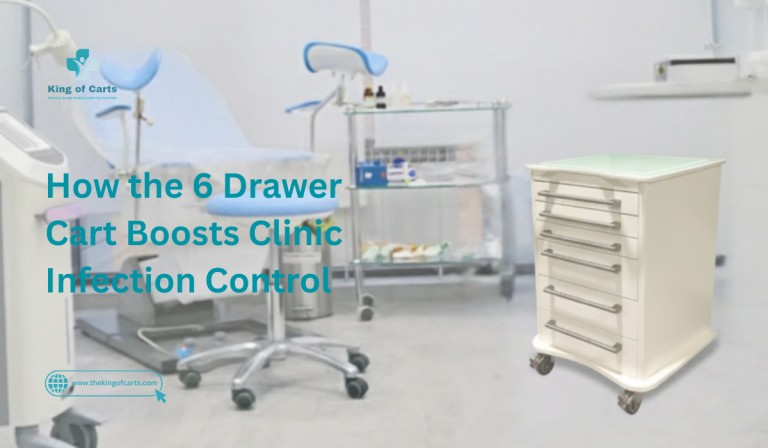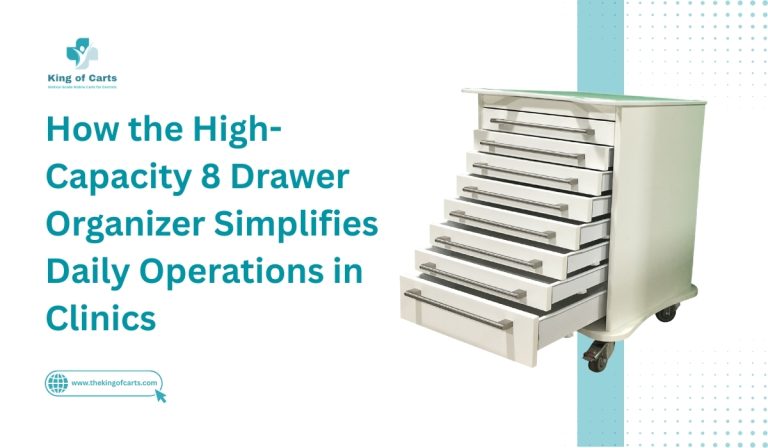Designing an efficient dental clinic goes far beyond choosing the right chair or lighting—it’s about how your space supports smooth workflow, patient comfort, and professional efficiency. One of the most impactful design choices you can make is deciding whether to use fixed cabinetry or mobile dental carts in your operatory setup.
Both approaches have distinct advantages, but understanding their impact on space, flexibility, and ergonomics can help you make the right decision for your practice. This blog explores the differences between clinic layouts with and without mobile dental carts, their benefits, and key considerations for an optimal clinic design.
Understanding Mobile Dental Carts
Mobile dental carts are compact, wheeled units designed to hold dental instruments, supplies, and utility connections such as air, water, and power. Unlike fixed cabinetry, these carts can be easily moved between operatories or repositioned during procedures.
They come in various configurations—assistant carts, doctor’s carts, utility carts, and delivery systems. Modern designs include built-in storage, cable management, and silent wheels for easy movement.
The primary goal of mobile carts is flexibility — allowing dentists and assistants to adapt their workspace quickly without being restricted by fixed infrastructure.
Traditional Dental Clinic Layout (Without Mobile Carts)
Before mobile systems became popular, most dental clinics followed a fixed layout. Here’s what that typically looks like:
- The dental chair is the central focus.
- Cabinets and drawers are mounted on walls or behind the dentist.
- Utilities (air, water, suction) are connected through built-in units.
- Instruments and supplies are stored within reach but in static locations.
This design emphasizes structure and permanence — everything has a dedicated place, and movement is minimal.
Advantages of Fixed Layouts
- Professional Look: Integrated cabinetry offers a neat, organized appearance.
- Durability: Built-in systems are long-lasting and robust.
- Stable Utility Connections: Plumbing and power lines are safely housed in walls or floors.
- Noise Control: Fixed setups tend to have less movement noise during procedures.
Limitations of Fixed Layouts
- Limited Flexibility: Once installed, equipment positions are difficult to change.
- Higher Renovation Costs: Modifying layouts requires expensive remodeling.
- Space Restrictions: Built-in cabinets consume valuable floor space.
- Workflow Constraints: Staff movement is restricted by static positions.
While fixed layouts still work well for large clinics or specialized practices, they can be restrictive in dynamic or space-limited environments.
Modern Dental Clinic Layout (With Mobile Carts)
Modern clinics prioritize flexibility and ergonomics, and mobile dental carts play a major role in this evolution. Instead of fixed cabinetry, mobile units can be positioned exactly where they’re needed — improving efficiency and comfort for both the dentist and the assistant.
These carts typically include multiple drawers, integrated delivery systems, and ergonomic handles. Some even connect directly to ceiling or floor utility ports, making them easy to reposition.
Advantages of Using Mobile Dental Carts
- Flexible Workflow: Easily reconfigure your operatory for different procedures or dentist preferences.
- Space Optimization: Ideal for smaller clinics — carts can be moved out when not in use.
- Ergonomic Efficiency: Reduces unnecessary reaching and turning.
- Ease of Cleaning: Open space under and around the cart simplifies cleaning and infection control.
- Cost-Efficient Upgrades: Carts can be replaced or upgraded individually without major renovation.
- Medical Grade: Medical carts are made from high-quality, durable materials that meet strict healthcare standards.
- Antimicrobial Technology: Antimicrobial coating prevents bacterial growth, ensuring a cleaner and safer workspace.
Considerations for Mobile Cart Layouts
- Utility Accessibility: Plan for floor or wall-mounted connection points.
- Flooring Requirements: Smooth, even floors ensure easy cart movement.
- Staff Training: Proper handling ensures safety and efficiency.
- Quality Investment: Low-quality wheels or poor build can affect durability.
Comparison: With vs. Without Mobile Carts
| Feature | Without Mobile Carts (Fixed Layout) | With Mobile Carts (Flexible Layout) |
| Design Flexibility | Low – fixed installations | High – modular and movable |
| Workflow Efficiency | Static, consistent setup | Dynamic, adaptable for procedures |
| Cleaning & Hygiene | Harder to clean corners | Easier to clean and sanitize |
| Space Utilization | More space occupied by cabinetry | Compact |
| Cost Over Time | High for modifications | Cost-effective for long-term |
| Upgrade Options | Requires remodeling | Replaceable or upgradable carts |
| Mobility | None | Full, easy mobility |
This table highlights how mobile dental carts offer superior adaptability in today’s fast-paced dental environments — especially where multi-specialty procedures or space optimization are priorities.
Designing a Clinic with Mobile Dental Carts
Transitioning to a mobile setup isn’t just about adding carts — it requires strategic design thinking. Here are some practical design tips for clinics integrating mobile systems:
- Plan Utility Points Wisely: Position air, water, and electrical outlets strategically on floors or walls to ensure easy accessibility and seamless cart mobility, preventing tangled cords or limited movement during dental procedures.
- Use Smooth, Durable Flooring: Choose vinyl or epoxy flooring for effortless cart movement and hygiene maintenance. Smooth, durable surfaces are easy to clean, complement antimicrobial carts, and prevent dirt buildup—supporting a sterile and professional environment.
- Keep the Layout Open: Design the operatory with minimal furniture to maintain open, unobstructed pathways. This allows staff and carts to move freely, improving coordination, efficiency, and overall workspace safety.
- Create Storage Zones: Set up specific docking or charging areas for mobile carts when not in use. Organized storage prevents clutter, ensures accessibility, and keeps high-traffic zones clear for smooth operations.
- Train the Team: Provide staff with proper training on cart handling—teaching safe movement, locking techniques, and ergonomic positioning to reduce strain, prevent accidents, and ensure efficient, professional use of equipment.
Case Examples
Case 1: Compact Urban Clinic: A small two-chair dental practice switched from built-in cabinetry to mobile dental carts. The result? Increased maneuvering space, reduced clutter, and improved cleaning efficiency between patients.
Case 2: Multi-Specialty Dental Center: A large clinic uses hybrid setups — fixed cabinets for bulk storage and mobile assistant carts for chairside operations. Each department personalizes cart configurations for its specific procedures.
Case 3: Pediatric Dental Practice: Pediatric clinics benefit from mobile systems that allow dentists to reposition quickly around patients, creating a friendly and adaptable environment.
Future Trends in Dental Clinic Design
As dental technology advances, flexible and modular design will dominate future clinics. Expect to see:
- Smart Mobile Carts: Equipped with digital controls, touchscreens, and built-in suction systems, these advanced carts enhance precision, streamline workflow, and allow dental professionals to work efficiently with modern technology integration.
- Wireless Utility Connections: By reducing cable clutter and enabling seamless power or data connections, wireless setups improve safety, mobility, and cleanliness while maintaining an organized, efficient operatory environment.
- Eco-friendly Designs:
Made from sustainable, durable materials, these carts promote environmental responsibility while maintaining strength and hygiene standards—helping clinics reduce waste and support green healthcare initiatives.
- Multi-purpose Operatories: Flexible treatment spaces that easily adapt to various procedures maximize efficiency, optimize space usage, and allow smoother transitions between dental tasks without disrupting patient comfort or workflow.
Conclusion
The choice between clinic layouts with or without mobile dental carts depends on your practice’s size, workflow, and long-term goals. Fixed setups offer structure, durability, and visual consistency, making them ideal for clinics that prefer a traditional and stable workspace. However, mobile dental carts provide unmatched flexibility, ergonomic benefits, and efficient space utilization—perfect for modern dental environments that value adaptability and workflow efficiency.
For growing or forward-thinking clinics, mobile carts are a smart investment. They streamline daily operations, enhance organization, and elevate the overall look and comfort of your workspace for both staff and patients. Whether you’re designing a new clinic or renovating an existing one, incorporating mobility ensures long-term functionality and success. Upgrade your practice today—choose premium mobile dental carts from The King of Carts and transform your clinic into a modern, efficient, and patient-friendly space.
